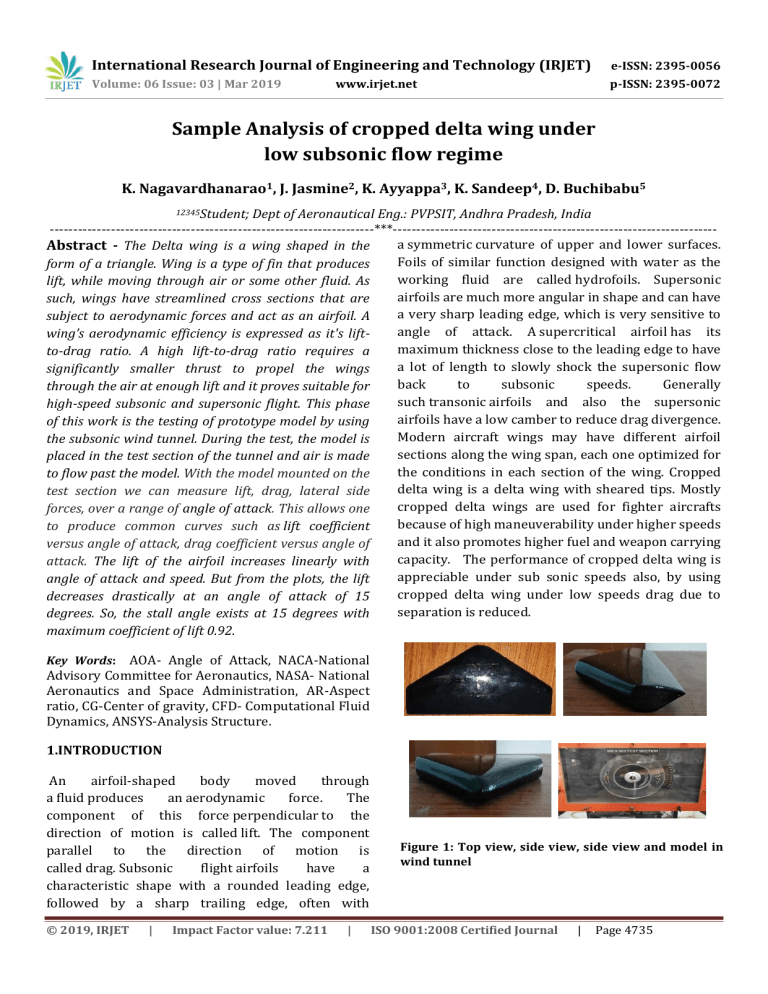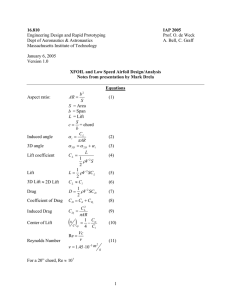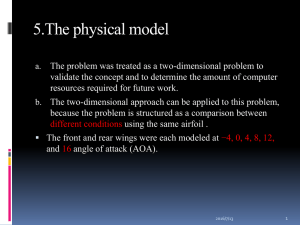IRJET-Sample Analysis of Cropped Delta Wing Under Low Subsonic Flow Regime
advertisement

International Research Journal of Engineering and Technology (IRJET) e-ISSN: 2395-0056 Volume: 06 Issue: 03 | Mar 2019 p-ISSN: 2395-0072 www.irjet.net Sample Analysis of cropped delta wing under low subsonic flow regime K. Nagavardhanarao1, J. Jasmine2, K. Ayyappa3, K. Sandeep4, D. Buchibabu5 12345Student; Dept of Aeronautical Eng.: PVPSIT, Andhra Pradesh, India ---------------------------------------------------------------------***--------------------------------------------------------------------a symmetric curvature of upper and lower surfaces. Abstract - The Delta wing is a wing shaped in the Foils of similar function designed with water as the form of a triangle. Wing is a type of fin that produces working fluid are called hydrofoils. Supersonic lift, while moving through air or some other fluid. As airfoils are much more angular in shape and can have such, wings have streamlined cross sections that are a very sharp leading edge, which is very sensitive to subject to aerodynamic forces and act as an airfoil. A angle of attack. A supercritical airfoil has its wing’s aerodynamic efficiency is expressed as it's liftmaximum thickness close to the leading edge to have to-drag ratio. A high lift-to-drag ratio requires a a lot of length to slowly shock the supersonic flow significantly smaller thrust to propel the wings back to subsonic speeds. Generally through the air at enough lift and it proves suitable for such transonic airfoils and also the supersonic high-speed subsonic and supersonic flight. This phase airfoils have a low camber to reduce drag divergence. of this work is the testing of prototype model by using Modern aircraft wings may have different airfoil the subsonic wind tunnel. During the test, the model is sections along the wing span, each one optimized for placed in the test section of the tunnel and air is made the conditions in each section of the wing. Cropped to flow past the model. With the model mounted on the delta wing is a delta wing with sheared tips. Mostly test section we can measure lift, drag, lateral side cropped delta wings are used for fighter aircrafts forces, over a range of angle of attack. This allows one because of high maneuverability under higher speeds to produce common curves such as lift coefficient and it also promotes higher fuel and weapon carrying versus angle of attack, drag coefficient versus angle of capacity. The performance of cropped delta wing is attack. The lift of the airfoil increases linearly with appreciable under sub sonic speeds also, by using angle of attack and speed. But from the plots, the lift cropped delta wing under low speeds drag due to decreases drastically at an angle of attack of 15 separation is reduced. degrees. So, the stall angle exists at 15 degrees with maximum coefficient of lift 0.92. AOA- Angle of Attack, NACA-National Advisory Committee for Aeronautics, NASA- National Aeronautics and Space Administration, AR-Aspect ratio, CG-Center of gravity, CFD- Computational Fluid Dynamics, ANSYS-Analysis Structure. Key Words: 1.INTRODUCTION An airfoil-shaped body moved through a fluid produces an aerodynamic force. The component of this force perpendicular to the direction of motion is called lift. The component parallel to the direction of motion is called drag. Subsonic flight airfoils have a characteristic shape with a rounded leading edge, followed by a sharp trailing edge, often with © 2019, IRJET | Impact Factor value: 7.211 | Figure 1: Top view, side view, side view and model in wind tunnel ISO 9001:2008 Certified Journal | Page 4735 International Research Journal of Engineering and Technology (IRJET) e-ISSN: 2395-0056 Volume: 06 Issue: 03 | Mar 2019 p-ISSN: 2395-0072 www.irjet.net 2. Super Critical Airfoil: Employing a supercritical airfoil would alters the flow separation at the trailing edge and used to reduce the flow separation responsible for drag reduction further. Super critical airfoil contains flat upper surface which accelerates the downstream to higher speeds which reduces the induced drag. NASA SC (2)-0410 3.NASA SC (2)-0412: A supercritical airfoil is an airfoil designed primarily to delay the onset of wave drag in the transonic speed range. Supercritical airfoils are characterized by their flattened upper surface, highly cambered ("downward-curved") aft section, and larger leading-edge radius compared with NACA 6 series laminar airfoil shapes. Standard wing shapes are designed to create lower pressure over the top of the wing. The camber of the wing determines how much the air accelerates around the wing. As the speed of the aircraft approaches the speed of sound the air accelerating around the wing reaches Mach 1 and shockwaves begin to form. The formation of these shockwaves causes wave drag. Supercritical airfoils are designed to minimize this effect by flattening the upper surface of the wing. Figure 3: Delta Wing Configuration And the model was fabricated using the wood, according to the dimensions of NASA SC (2) 0410. The model is shown in the figure3 the tests were conducted in low subsonic wind tunnel. 3.2. TESTING The lift, drag and side forces are obtained from the wind tunnel testing and the coefficients are calculated using the formulae results are depicted in the tables. The airfoil seleed for this analysis is NASA SC (2) -0410. Coefficient of lift = Drag coefficient = Coefficient of side force = 3.3. Results and Discussion: Figure 2: Super Critical Airfoil 3. METHODLOGY Scaling Fabrication of model Wind tunnel testing Calculation of coefficient lift, drag and side force Flow analysis using Ansys software 3.1. Fabrication of model Due to the experimental constrains of wind tunnel experiments were carried out on scaled model with wing span of 25 cm, Root chord of 18cm, Tip chord of 8cmand wing area32.5cm. © 2019, IRJET | Impact Factor value: 7.211 | TABLE 1: ANALYTICAL RESULTS FOR THE FLOW VELOCITY V=35m/s: A LIFT Cl DRAG Cd SIDE Cs -2.3 -0.9253 0.61 0.2454 0.01 0.00402 20 -1.23 -0.4948 0.29 0.11667 0.03 0.01207 15 -0.38 -0.1529 0.18 0.07241 0.01 0.00402 10 -5 -0.05 -0.0201 0.16 0.06437 -0.01 -0.004 0 0.45 0.18103 0.15 0.06034 0 0 5 1.06 0.42643 0.23 0.09253 -0.02 -0.008 10 1.54 0.61953 0.48 0.1931 -0.01 -0.004 15 20 1.74 1.4 0.69999 0.56321 0.68 0.74 0.27356 0.2977 ISO 9001:2008 Certified Journal | 0 -0.01 Page 4736 0 -0.004 International Research Journal of Engineering and Technology (IRJET) e-ISSN: 2395-0056 Volume: 06 Issue: 03 | Mar 2019 p-ISSN: 2395-0072 www.irjet.net TABLE 5: ANALYTICAL RESULTS FOR THE FLOW VELOCITY V=55m/s: TABLE 2: ANALYTICAL RESULTS FOR THE FLOW VELOCITY V=40m/s: A LIFT Cl DRAG Cd SIDE -20 2.89 -0.89 0.76 0.02341 0.02 -15 -1.41 -0.434 0.33 0.1016 0.03 -10 -0.47 -0.145 0.21 0.0647 0.01 -5 -0.08 -0.025 0.19 0.0585 -0.01 0 0.59 0.1817 0.2 0.0616 0 5 1.32 0.4066 0.25 0.077 -0.02 10 1.91 0.5883 0.58 0.1786 -0.01 15 2.25 0.693 0.91 0.2803 0 20 1.77 0.5452 0.95 0.2926 -0.01 Cs 0.0062 0.0092 0.0031 -0.003 0 -0.006 -0.003 0 -0.003 TABLE 3: ANALYTICAL RESULTS FOR THE FLOW VELOCITY V=45m/s: A LIFT Cl DRAG Cd SIDE -20 -3.74 -0.91 0.95 0.2312 0.02 -15 -1.73 -0.421 0.42 0.1022 0.04 -10 -0.6 -0.146 0.28 0.0681 0.01 -5 -0.11 -0.027 0.24 0.0584 -0.01 0 0.75 0.1825 0.24 0.0584 0 5 1.74 0.4235 0.32 0.0779 -0.03 10 2.47 0.6011 0.77 0.1874 -0.02 15 2.71 0.6595 1.1 0.2677 0 20 2.36 0.5743 1.23 0.2993 -0.01 Cs 0.0049 0.0097 0.0024 -0.002 0 -0.007 -0.005 0 -0.002 TABLE 4: ANALYTICAL RESULTS FOR THE FLOW VELOCITY V=50m/s: A LIFT Cl DRA Cd SIDE G -20 -4.96 -0.978 1.09 0.2149 0.04 -15 -2.02 -0.398 0.5 0.0986 0.04 -10 -0.71 -0. 14 0.34 0.067 0.01 -5 -0.13 -0.026 0.29 0.0572 -0.01 0 0.95 0.1873 0.29 0.0572 0 5 2.14 0.4218 0.37 0.0729 -0.03 10 3.14 0.619 0.97 0.1912 -0.03 15 3.51 0.6919 1.37 0.2701 0.02 20 3.03 0.5973 1.58 0.3115 -0.02 A LIFT Cl DR AG Cd SIDE Cs -20 -15 -10 -5 0 5 10 15 20 -5.18 -2.42 -0.81 -0.14 1.33 2.62 3.92 4.62 4.05 -0.84389 -0.39425 -0.13196 -0.02281 0.21667 0.42683 0.63862 0.75266 0.6598 1.16 0.59 0.41 0.37 0.38 0.46 1.17 1.72 2.01 0.189 0.0961 0.0668 0.0603 0.0619 0.0749 0.1906 0.2802 0.3275 0.06 0.04 0.01 -0.01 -0.02 -0.03 -0.04 -0.01 -0.02 0.0098 0.0065 0.0016 -0.002 -0.003 -0.005 -0.007 -0.002 -0.003 TABLE 6: ANALYTICAL RESULTS FOR THE FLOW VELOCITY V=60m/s: A LIFT Cl DRA Cd SIDE Cs G -20 -0.89 -0.122 0.46 -0.002 0.01 0.0013 -15 -0.89 -0.122 0.46 -0.017 0.01 0.0014 -10 -0.89 -0.122 0.46 -0.017 0.01 0.0014 -5 -0.14 -0.019 0.42 0.003 -0.02 -0.003 0 1.57 0.214 0.43 0.0294 -0.02 -0.003 5 4.08 0.558 0.87 0.0765 -0.22 -0.03 10 4.9 0.670 1.46 0.0918 -0.14 -0.019 15 5.67 0.776 2.07 0.1063 -0.1 -0.014 20 5.23 0.715 2.52 0.098 -0.02 -0.003 Cs 0.0079 0.0079 0.002 -0.002 0 -0.006 -0.006 0.0039 -0.004 Lift coefficient © 2019, IRJET | Impact Factor value: 7.211 | ISO 9001:2008 Certified Journal | Page 4737 International Research Journal of Engineering and Technology (IRJET) e-ISSN: 2395-0056 Volume: 06 Issue: 03 | Mar 2019 p-ISSN: 2395-0072 www.irjet.net CL AT 35m/s CL AT 50 m/s 1 1 0.5 0.5 0 -30 -20 -10 0 10 20 30 0 -0.5 -30 -20 -10 0 10 20 30 -0.5 -1 -1 -1.5 -1.5 CL AT 55m/s CL AT 40m/s 1 1 0.5 0.5 0 0 -30 -20 -10 0 10 20 -30 30 -20 -10 0 -0.5 -0.5 -1 -1 CL AT 45M/S 10 20 30 CL AT 60 m/s 1 1 0.8 0.5 0.6 0.4 0 -30 -20 -10 0 10 20 30 0.2 -0.5 0 -30 -1 -20 -10 -0.2 0 10 20 Drag coefficient © 2019, IRJET | Impact Factor value: 7.211 | ISO 9001:2008 Certified Journal | Page 4738 30 International Research Journal of Engineering and Technology (IRJET) e-ISSN: 2395-0056 Volume: 06 Issue: 03 | Mar 2019 p-ISSN: 2395-0072 www.irjet.net CD AT 35m/s CD AT 50 m/s 0.35 0.35 0.3 0.3 0.25 0.25 0.2 0.2 0.15 0.15 0.1 0.1 0.05 0 0.05 -30 0 -30 -20 -10 0 10 20 -20 -10 0 10 20 30 30 CD AT 40m/s CD AT 55 m/s 0.35 0.35 0.3 0.3 0.25 0.25 0.2 0.2 0.15 0.15 0.1 0.05 0.1 0 0.05 -30 -20 -10 0 10 20 30 0 -30 -20 -10 0 10 20 30 CD AT 60m/s CD AT 45M/S 0.012 0.35 0.01 0.3 0.008 0.25 0.006 0.2 0.004 0.15 0.002 0.1 -30 0.05 -20 -10 0 -10 -0.002 0 10 20 -0.004 0 -30 -20 0 10 20 30 Side coefficient © 2019, IRJET | Impact Factor value: 7.211 | ISO 9001:2008 Certified Journal | Page 4739 30 International Research Journal of Engineering and Technology (IRJET) e-ISSN: 2395-0056 Volume: 06 Issue: 03 | Mar 2019 p-ISSN: 2395-0072 www.irjet.net CS AT 50 m/s Cs AT 35m/s 0.015 0.01 0.008 0.01 0.006 0.004 0.005 0.002 0 -30 -20 -10 -30 0 10 20 0 -10 -0.002 0 -20 30 10 20 30 -0.004 -0.005 -0.006 -0.008 -0.01 CS AT 40m/s -30 0.012 0.01 0.008 0.006 0.004 0.002 0 -10 -0.002 0 -0.004 -0.006 -0.008 -20 10 CS AT 55 m/s 20 30 -30 -20 CS 0.012 0.01 0.008 0.006 0.004 0.002 0 -10-0.002 0 -0.004 -0.006 -0.008 10 20 30 CS AT 45M/S -30 0.012 0.01 0.008 0.006 0.004 0.002 0 -10 -0.002 0 -0.004 -0.006 -0.008 -0.01 -20 CS AT 60m/s 0.005 -30 -20 0 -10 -0.005 0 10 20 -0.01 -0.015 10 20 30 -0.02 -0.025 -0.03 -0.035 Coefficient of lift, drag and side force © 2019, IRJET | Impact Factor value: 7.211 | ISO 9001:2008 Certified Journal | Page 4740 30 International Research Journal of Engineering and Technology (IRJET) e-ISSN: 2395-0056 Volume: 06 Issue: 03 | Mar 2019 p-ISSN: 2395-0072 www.irjet.net CD AT VARIOUS VELOCITIES 0.4 CD AT 35M/S 0.3 CD AT 40M/S 0.2 CD AT 45M/S 0.1 CD AT 50M/S CD AT 55M/S 0 -30 -20 -10 0 -0.1 10 30 CD AT 60M/S 20 CS AT VARIOUS VELOCITIES 0.02 CS AT 35M/S 0.01 CS AT 40M/S 0 -40 -20 -0.01 0 20 40 CS AT 45M/S CS AT 50M/S -0.02 CS AT 55M/S -0.03 CS AT 60M/S -0.04 For all the wings the lift increases linearly with angle of attack and speed. But from the plots the lift decreases drastically at an angle of attack15 degrees. So, the angle of stalling exists at 15 degrees with maximum lift coefficient 0.8. The performance of a cropped delta wing is quite appreciable, and the max drag obtained is 0.12. There is no effect of side forces observed 3.4. Flow Analysis using Ansys Figure 4. Generation of all keypoints and edges of airfoil The aim of this research is to analyze the behavior of the air flow at the internal cavity of the NASA SC (2)-0410 airfoil and predict possible zones of flow separation at the suction surface of this airfoil. A two-dimensional numerical simulation by using CFD will be performed to obtain velocity fields, pressure fields, temperature, density and streamlines of the flow. ANSYS workbench is the numerical type of engineering problem solving software. Used to simulate interactions of all disciplines of physics, structural, vibration, fluid dynamics, heat transfer and electromagnetic for engineers. Air foil geometry of NASA SC (2)-0410 is derived from the CSV file of coordinates. These coordinates of the respective airfoil are imported to the ANSYS FLUID FLOW (FLUENT) © 2019, IRJET | Impact Factor value: 7.211 | ISO 9001:2008 Certified Journal | Page 4741 International Research Journal of Engineering and Technology (IRJET) e-ISSN: 2395-0056 Volume: 06 Issue: 03 | Mar 2019 p-ISSN: 2395-0072 www.irjet.net Figure 5. Mesh Generation figure 7. pressure contour The first phase ‘Geometry’ is to import the coordinates of the airfoil into the ANSYS Fluid Flow and to generate the airfoil. The new Geometry is opened, and the points are created respectively. The coordinates are imported from the coordinates file and the coordinates units are changed to Millimeters. The airfoil is generated successfully as shown in figure4.The outline of the airfoil which is formed in the Geometry process is appeared in this section. Here the four sides of the rectangle are named. The left side of the rectangle is named as the inlet. The right side of the rectangle is named as outlet. The upper and lower sides are named as the Tunnel Wall. The airfoil outline is selected and named as the airfoil wall as depicted in the figure5. Figure 8: Streamlines Figure 6: Velocity contour Figure 9: Tunnel Wall © 2019, IRJET | Impact Factor value: 7.211 | ISO 9001:2008 Certified Journal | Page 4742 International Research Journal of Engineering and Technology (IRJET) e-ISSN: 2395-0056 Volume: 06 Issue: 03 | Mar 2019 p-ISSN: 2395-0072 www.irjet.net Figure10: Mesh view of streamlines Figure 12: Velocity in Ball Streamlines 4.Conclusion: The lift of the airfoil increases linearly with angle of attack and speed. But from the plots, the lift decreases drastically at an angle of attack of 15 degrees. So, the stall angle exists at 15 degrees with maximum coefficient of lift 0.92. According to experimentation and computational analysis the performance of a cropped delta wing is quite appreciable, and the maximum drag obtained is 0.2, since there is no effect of side forces observed. The maximum lift on the cropped delta wing under the supersonic flow and subsonic flow are similar at 15 degrees angle of attack. Figure11: Streamlines at 10contour points There is a possibility of using cropped delta wings for civil aircrafts, that having higher maneuverability at lower speeds. The velocity fields, pressure fields, temperature, density and streamlines of the flow and graphs have been plotted, and the flow patterns are captured necessarily. 5.Future work: Since the results presented in this work for lift calculation are only through basic formulae which only depend on are of the delta wing, a flow analysis could be done in order to determine the lift-off performances, vortices reduction. The pressure distribution can be done by using the pressure tapings. © 2019, IRJET | Impact Factor value: 7.211 | ISO 9001:2008 Certified Journal | Page 4743 International Research Journal of Engineering and Technology (IRJET) e-ISSN: 2395-0056 Volume: 06 Issue: 03 | Mar 2019 p-ISSN: 2395-0072 www.irjet.net The distribution of laminar and turbulent flow in the boundary layer of a delta wing is difficult to resolve experimentally and to predict computationally even for sharp-edged wing. Fluid Dynamics Conference, 28 June - 1 July 1999, Norfolk, VA. Pressure distribution on delta wing should be done and a finite element analysis could be performed to calculate structural integrity using Finite Element Analysis tools like ANSYS or CATIA. 6.References: 1. Text book of Introduction to aerodynamics by John D Anderson. 2. Text book of Introduction to flight by John D Anderson. 3. Anderson J.D., Corda S., Van Wie, D.M. Numerical LiftingLine Theory Applied to Drooped Leading Edge Wings Below and Above Stall // Journal of Aircraft. – 1980. – Vol 17, No 12. – P. 898–904. 4. Barnes J P. Semi-Empirical Vortex Step Method for the lift and induced drag loading of 2D and 3D Wings // SAE Paper / Society of Automotive Engineers. – 1997 Oct. – No 975559. 5. Blackwell J.A. A Finite-Step Method for Calculation of Theoretical Load Distributions for Arbitrary LiftingSurface Arrangements at Subsonic Speeds // NASA TN D5335. – 1969 July. 6. E.H. Dowell (Editor), A Modern Course in Aeroelasticity. Kluwer Academic Publishers, 2004. 7. R.E. Gordnier, Computation of limit cycle oscillations of a delta wing, in: 43rd AIAA/ASME/ASCE/AHS/ASC Structures, Structural Dynamics, and Materials Conference, 22-25 April 2002, Denver, Colorado, USA. 8 R.E. Gordnier, Computation of limit-cycle oscillations of a delta wing, Journal of Aircraft, 40, 2003, 1206-1207. 9. P. Attar, R.E. Gordnier, Aeroelastic prediction of the limit cycle oscillations of a cropped delta wing, in: 46th AIAA/ASME/ASCE/AHS/ASC Structures, Structural Dynamics & Materials Conference, 18-21 April 2005, Austin, Texas, USA. 10. E.T. Schairer, L.A. Hand, Measurements of unsteady aeroelastic model deformation by stereo photogrammetry, Journal of Aircraft, 36, 1999, 1033-1040. 11. R.E. Gordnier, R.B. Melville, Physical mechanisms for limit-cycle oscillations of a cropped delta wing, 30th AIAA © 2019, IRJET | Impact Factor value: 7.211 | ISO 9001:2008 Certified Journal | Page 4744


